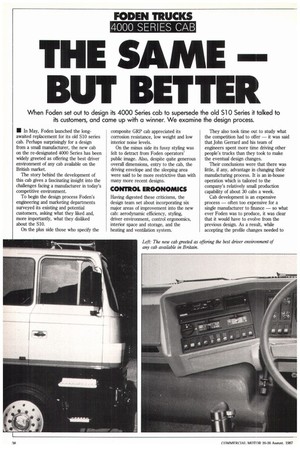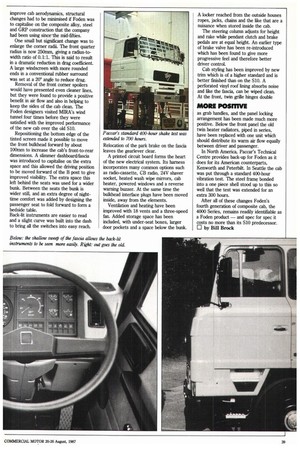THE SAM
Page 40

Page 41

If you've noticed an error in this article please click here to report it so we can fix it.
BUT BETTER
When Foden set out to design its 4000 Series cab to supersede the old S10 Series it talked to its customers, and came up with a winner. We examine the design process.
• In May, Foden launched the longawaited replacement for its old S10 series cab. Perhaps surprisingly for a design from a small manufacturer, the new cab on the re-designated 4000 Series has been widely greeted as offering the best driver environment of any cab available on the British market.
The story behind the development of this cab gives a fascinating insight into the challenges facing a manufacturer in today's competitive environment To begin the design process Foden's engineering and marketing departments surveyed its existing and potential customers, asking what they liked and, more importantly, what they disliked about the S10.
On the plus side those who specify the composite GftP cab appreciated its corrosion resistance, low weight and low interior noise levels.
On the minus side its fussy styling was felt to detract from Foden operators' public image. Also, despite quite generous overall dimensions, entry to the cab, the driving envelope and the sleeping area were said to be more restrictive than with many more recent designs.
CONTROL ERGONOMICS
Having digested these criticisms, the design team set about incorporating six major areas of improvement into the new cab: aerodynamic efficiency, styling, driver environment, control ergonomics, interior space and storage, and the heating and ventilation system. They also took time out to study what the competition had to offer — it was said that John Gerrard and his team of engineers spent more time driving other people's trucks than they took to make the eventual design changes.
Their conclusions were that there was little, if any, advantage in changing their manufacturing process. It is an in-house operation which is tailored to the company's relatively small production capability of about 30 cabs a week.
Cab development is an expensive process — often too expensive for a single manufacturer to finance — so what ever Foden was to produce, it was clear that it would have to evolve from the previous design. As a result, while accepting the profile changes needed to improve cab aerodynamics, structural changes had to be minimised if Foden was to capitalise on the composite alloy, steel and GRP construction that the company had been using since'the mid-fifties.
One small but significant change was to enlarge the corner radii. The front quarter radius is now 250mm, giving a radius-towidth ratio of 0.1:1. This is said to result in a dramatic reduction in drag coefficient. A large windscreen with more rounded ends in a conventional rubber surround was set at a 20° angle to reduce drag.
Removal of the front corner spoilers would have presented even cleaner lines, but they were found to provide a positive benefit in air flow and also in helping to the sides of the cab clean. The Foden designers visited MIRA's wind tunnel four times before they were satisfied with the improved performance of the new cab over the old S10.
Repositioning the bottom edge of the tinted screen made it possible to move the front bulkhead forward by about 100nun to increase the cab's front-to-rear dimensions. A slimmer dashboard/fascia was introduced to capitalise on the extra space and this allowed the driving position to be moved forward of the B post to give improved visibility. The extra space this left behind the seats was used for a wider bunk. Between the seats the bunk is wider still, and an extra degree of nighttime comfort was added by designing the passenger seat to fold forward to form a bedside table.
Back-lit instruments are easier to read and a slight curve was built into the dash to bring all the switches into easy reach, Relocation of the park brake on the fascia leaves the gearlever clear.
A printed circuit board forms the heart of the new electrical system. Its harness incorporates many common options such as radio-cassette, CB radio, 24V shaver socket, heated wash wipe mirrors, cab heater, powered windows and a reverse warning buzzer. At the same time the bulkhead interface plugs have been moved inside, away from the elements.
Ventilation and heating have been improved with 18 vents and a three-speed fan. Added storage space has been included, with under-seat boxes, larger door pockets and a space below the bunk.
A locker reached from the outside houses ropes, jacks, chains and the like that are a nuisance when stored inside the cab.
The steering column adjusts for height and rake while pendant clutch and brake pedals are at equal height. An earlier type of brake valve has been re-introduced which has been found to give more progressive feel and therefore better driver control.
Cab styling has been improved by new trim which is of a higher standard and is better finished than on the S10. A perforated vinyl roof lining absorbs noise and like the fascia, can be wiped clean. At the front, twin grille hinges double
MORE POSITIVE
as grab handles, and the panel locking arrangement has been made much more positive. Below the front panel the old twin heater radiators, piped in series, have been replaced with one unit which should distribute its warm air flow equally between driver and passenger.
In North America, Paccar's Technical Centre provides back-up for Foden as it does for its American counterparts, Kenworth and Peterbilt. In Seattle the cab was put through a standard 400-hour vibration test. The steel frame bonded into a one piece shell stood up to this so well that the test was extended for an extra 300 hours.
After all of these changes Foden's fourth generation of composite cab, the 4000 Series, remains readily identifiable as a Foden product — and spec for spec it costs no more than its S10 predecessor.
• by Bill Brock




















































































